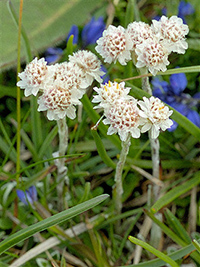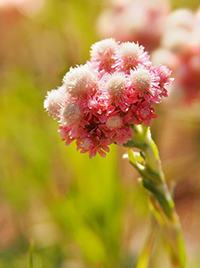Table of Contents

The cats foot plant evokes the smoothness of cats. Its flowers resemble the pad that covers the claws of such felines. It has been used from the 18th century onwards. For some time, the plant was supposed to have anticancerous and tuberculosis-healing properties, which could not be proven.
Healing Properties and Indications
The whole plant, and especially its female flower clusters, contains mucilage, to which it owes its bechic (alleviates throat irritation), expectorant, and anti-inflammatory actions on the respiratory passages. In its composition, we will also find flavonoids, to which its cholagogue properties are due (the plant promotes the emptying of the gall bladder).
Its main application is for respiratory afflictions (easing the irritation of the throat and the itching), dry cough, and bronchial catarrh (liquefying the mucus and promoting expectoration). An ideal way to use it is to combine its internal use (infusion) with its external use (gargle).
It can also be used in biliary dyskinesia (atony of the gall bladder) in combination with other plants that have active action on the bile duct.
Cats Foot Plant Scientific Facts


- Other names: Mountain everlasting
- French: Pied de chat.
- Spanish: Pie de gato
- Environment: Common to mountain meadows throughout Europe, the plant is also found on the Pacific North American Coast.
- Description: Dioicous vivacious plant of the Compositae family, growing from five to 20 cm high, with hairy leaves, white in their underside, and forming a basal rose. The masculine flower clusters are white, while the female flower clusters are pink.
- Parts of the plant used medicinally: The female flower clusters (pink colored) when dried.
How to use Cats Foot
- Infusion with 30-40 g of dry female flower clusters per liter of water, drinking three or four cups daily, sweetened with honey.
- Gargle for five to ten minutes, three times a day, with the same infusion employed for internal use, not swallowing the liquid.
Frequently Asked Question
What are the traditional uses of cats foot?
Are there any studies backing up the health benefits of cats foot?
There is very little modern scientific research on its purported benefits for humans. Some animal studies suggest antispasmodic effects on the intestines, which might offer some support for its traditional use in digestive issues.
What are the active compounds in cats foot?
Research is ongoing, but the plant likely contains:
1. Flavonoids: Antioxidants with potential anti-inflammatory properties
2. Tannins: Potentially astringent and antispasmodic
3. Mucilage: Soothing and lubricating substances
Could cats foot help with inflammatory conditions?
The plant’s antioxidants and limited, traditional use for sore throat suggest a possible anti-inflammatory effect.
Is cats foot safe?
Generally considered safe:
Cats foot is usually well-tolerated in typical doses. Side effects, if any, are mild (e.g., temporary stomach upset).
Important Cautions:
Pregnancy & Breastfeeding: Avoid cats foot as safety is unknown
Interactions: No known significant drug interactions, but always consult your doctor before combining herbal remedies with medications.
Can cats foot be used with other herbs?
Possibly: In traditional medicine, it was sometimes combined with herbs like yarrow or chamomile, depending on the intended use. More research is needed on the safety and efficacy of these combinations.
How is the plant typically prepared?
Teas & Infusions: The most common method is to use dried flowers in a tea or infusion.
Tinctures: Less common but can be prepared with alcohol extraction.
Are there any dosage guidelines?
Lack of Standardization: There are no official dosage guidelines due to the lack of research. Start with a low dose and gradually increase if needed, observing any effects.
Where can I find reliable information about this plant?
Trustworthy sources include:
1. Reputable herbal databases (Examine.com, WebMD)
2. Scientific journals (check PubMed or Google Scholar for research)
3. University of Maryland Medical Center:
Should I take cats foot for a diagnosed health condition?
NO: Never substitute cats foot or any other herb for professional medical advice and treatment. Always consult your healthcare provider before starting herbal remedies, especially if you have an existing health condition.
DISCLAIMER: All content on this website is presented solely for educational and informational objectives. Do not rely on the information provided as a replacement for advice, diagnosis, or treatment from a qualified medical expert. If you are pregnant, nursing, or have any preexisting medical concerns, talk to your doctor before using any herbal or natural medicines.
REFERENCES
- George D. Pamplona-Roger, M.D. “Encyclopedia of Medicinal Plants.” George D. Pamplona-Roger, M.D. Encyclopedia of Medicinal Plants. Ed. Francesc X. Gelabert. Vols. 1 San Fernando de Henares: Editorial Safeliz, 2000. 297. Print. [cats foot plant]
- WebMD: https://www.webmd.com/vitamins/ai/ingredientmono-53/cats-foot
- RxList: https://www.rxlist.com/supplements/cats_foot.htm
